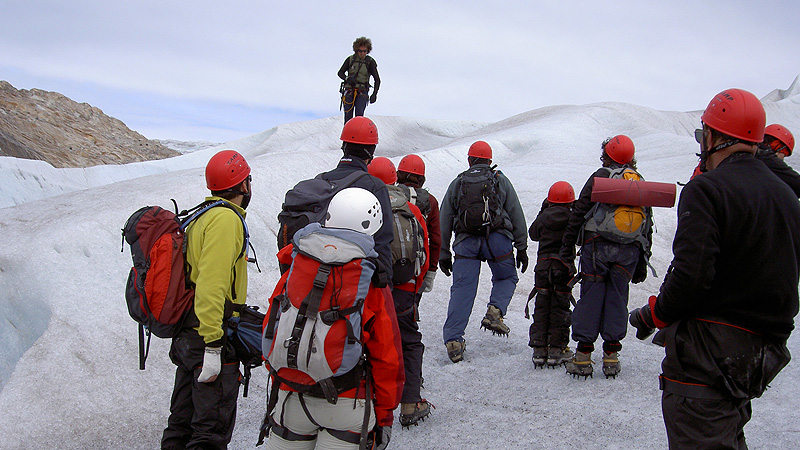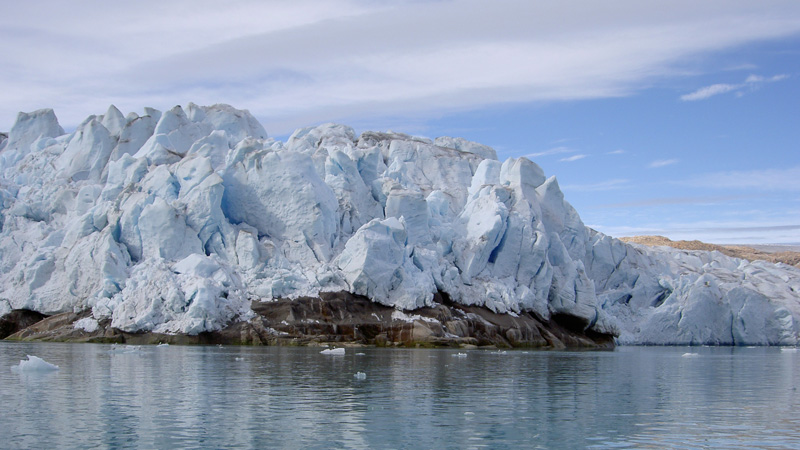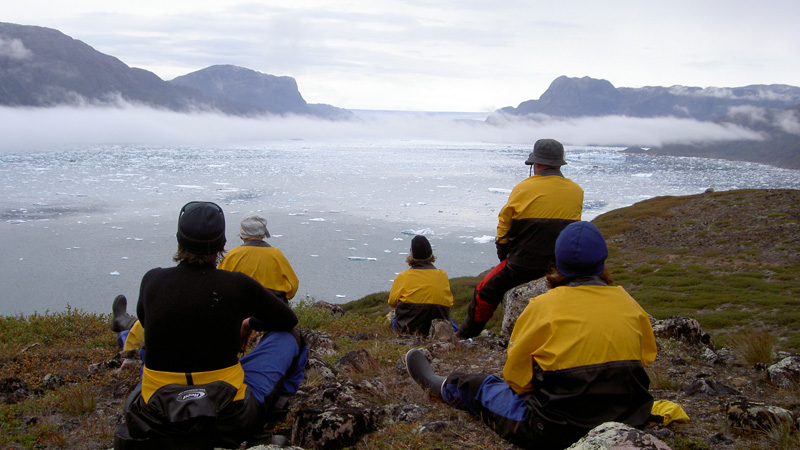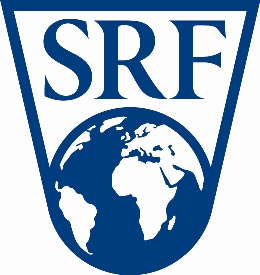NOTE: This itinerary is a unique journey, designed and organised by Tasermiut, South Greenland Expeditions. It keeps the adventure and discovery ingredients present in all our journeys. The route can be done as it is explained above or in reverse order. The order of the activities may not be exactly as planned in this outline. Greenland is the wildest country in the northern hemisphere, infrastructures are almost non-existent and logistics pose enormous challenges. That is the reason why we may not follow this daily itinerary exactly as planned. It is subject to change in order to adapt the journey to the weather conditions, sea conditions, or technical and organisational difficulties, and it therefore requires flexibility by the traveller.
ADDITIONAL INFORMATION
Guide
The Guide’s job is to point the group in the right direction, to ensure all travellers’ safety and to solve any possible problems that may arise along the itinerary, making changes or adjustments if necessary. Activities such as setting up the tents in the camp or taking them down, making lunch or other shared activities will be everybody’s responsibility, including the guide’s.
Physical Condition
This trip, considered as “active”, is physically challenging but it is designed so that it is suitable for anyone who enjoys the outdoors, who doesn´t mind sleeping in a tent and goes hiking or trekking on a regular basis.
During the treks, each participant will carry their own equipment in their backpack. Common equipment such as tents, cookers, etc., will be found in the camps, in waterproof storage containers.
It is not absolutely necessary to have had prior experience in a kayak in order to participate in our trip, because the kayaks are stable, wide and safe, although if you haven't got any experience, we do recommend that you take a course and practise all you can before the trip. Travelling in these kayaks is not technically difficult, and is only done when conditions are favourable.
In the two-person kayaks, those in better shape will be paired with those who are a little less fit, so that the group can be balanced. The trip is not recommended only for those with serious back problems, due to the difficulties that can result from carrying the kayaks from the beach to the water and back.
We recommend that those who are in doubt about their physical abilities take a weekend kayak trip (ask Tasermiut, South Greenland Expeditions).
Camps
Mellem Camp is located in the highlands of Narsarsuaq Mountains, and can only be reached on foot or by helicopter. It has a comfortable kitchen-dining hut which is supplied with cooker and utensils, and tents for sleeping. It is a pre-installed camp which will have to be set up when the group arrives.
The first night after arrival will be spent in tents which we will find in storage on our way.
Tasiusaq Camp is located along the shores of Sermilik Fjord, inland from Tasiusaq Bay. The dining tent is a reproduction of a traditional Inuit summer lodge. Igloo-type tents are provided for sleeping. The camp will be pre-installed upon our arrival.
Hostels
At Qassiarsuk we will spend the night at the Leif Eriksson Hostel, located next to the notable, Viking marine monument. It is a clean and cosy hostel, with a spacious terrace overlooking the fjord, different rooms, with shared toilets and showers. We will use sleeping bags at night. Overnight stays at the Leif Eriksson Hostel may be substituted by overnight stays at another local hostel.
Communication and Safety
Main mobile telephone networks can be reached in villages and in some parts of the coast.
At the start of the trip, the guide will share some basic tips on behaviour, safety and kayak self-rescue.
While travelling by kayak, each participant will wear a special suit and a life jacket. The expedition is carried out in an area of protected fjords where there are hardly any waves, and winds are usually very light. Travelling by kayak is only done when conditions are optimum, and, with few exceptions, along the coast.
Food
In the middle of the journey, we will enjoy a special Eskimo dinner that will include local products available: cooked and dried seal meat and fat, stewed whale meat, raw whale meat, caribou meat, smoked halibut, dried anmmassat and cod,…
During the day trips we will follow a more practical diet:
Breakfast: Coffee, tea, infusions, cocoa, powdered milk, biscuits, bread, jam, muesli and cereals.
Packed lunch: Bread, cheese, chorizo, salami, ham, foie-gras, chocolate, nuts, biscuits, soup, hot tea…
Dinner: Meals cooked at the camp. Rice, pasta, fish, mashed potatoes and meat, sausages, bacon, chorizo, tuna, squid…
Northern Lights
The northern lights are one of the most wonderful of nature’s phenomena on our planet, a beautiful, delightful display of movement and light against the dark polar skies on clear, calm nights.
It is usually possible to witness the aurora in winter. Late summer, however, especially in September, is the best time of the year to watch it in Southern Greenland, which is famous for offering some of the best places to view this spectacular natural display. In July, there is more sunlight and therefore it is not so easy to see it, but in August it can be seen more often, and from September onwards, the aurora can be seen almost every day when the skies are clear.
Fishing and Fruit picking
The rivers, lakes and even the fjords in the area surrounding Tasiusaq and Qassiarsuk are very good spots for fishing.
Weather
Weather in Greenland is very changeable. It is usually pleasant, but it is essential that you bring appropriate clothes for rainy weather. Temperatures are often more than 15ºC in July and between 5 º C and 10 º C in August. Mid-August nights are sometimes very cold. In September, temperatures are usually between 5ºC to 8ºC during the day and may reach minus 5ºC at night.
State of the Ice
Tasiusaq area gets large quantities of ice in the form of icebergs, which come from the nearby glaciers. The saturation of ice in this area can even end up impeding navigation in certain spots (although this is not common). If this happens, the route will be changed as a result.
USEFUL INFORMATION FOR THE TRAVELLER
Passport and visa regulations
You must have a valid passport which expires no less than three months after your stay in Greenland. A visa is not necessary unless you come from a country where a visa is required to enter Denmark. Ask us what the specific requirements from your country are.
Vaccine
You do not need to have any vaccinations for Greenland
Language
Kalaallisut, the Western Greenlandic language, is the main language in Greenland. It is spoken by 40.000 people, which makes it the most important Inuit language in the world. Inuhumiutut is also spoken in the North, and Tunumiutut in the West Coast. Most people in Greenland speak some Danish, which is the second official language. Many speak English too, with various levels of fluency, especially young people.
Greenlandic has an agglutinating structure. It belongs to the Inuit-Aleut family of languages, and it is spoken by people in different areas, from the Aleutian Islands up to the west coast in Greenland. It is of Asian origin, as is the Inuit race.
The country
Greenland is one of the most singular countries in the world: A huge island that holds a glacier measuring two million square kilometres in size, surrounded by a coastal mountainous belt, bathed by a sea which due to its Arctic climate remains frozen most of the year.
Some 57.000 inhabitants, mostly Inuit depending on fishing, hunting and farming, live on the coast. Greenland is now semi-independent from Denmark, the colonising country. The most populated area is the west coast, where Nuuk – the capital of the country, with 15.000 inhabitants – is located. Northern and Eastern Greenland are almost uninhabited.
Transport
Roads are almost non-existent, except in towns. The most common means of transport are therefore boats, planes, helicopters and dog sledges.
EQUIPMENT PROVIDED
Camping equipment
• Tents
• Camping stoves and cooking accessories, kitchen utensils,…
• Fuel
• First-aid kit
Communication
• The boats will be equipped with a radio to be used at sea.
• Mobile phone
• Delorme Satellite Messenger
Orientation and weather conditions
• GPS
• Compass
• Maps
Travelling materials
• Very stable double kayaks
• 2 replacement paddles
PERSONAL EQUIPMENT PROVIDED
Kayaking clothing
• Semi-dry raincoat
• Semi-dry cordura trousers
• Spray skirts
• Life jacket
• Paddling mittens
• Rubber boots
Travelling materials
• Dry bags
• Paddle
• 1 bilge pump (per kayak)
RECOMMENDED PERSONAL EQUIPMENT NOT PROVIDED BY TASERMIUT
Head
• Fleece hat (or wollen)
• Sunglasses
• Sun cream (we recommend strong protection against UVA rays)
• Lip balm (with sun block)
• Mosquito head net (recommended if you come before mid August. It may be possible to purchase it at Narsarsuaq. Please confirm first with Tasermiut).
• Peak cap (to use with the mosquito net)
Body
• Waterproof jacket
• A pair of light waterproof trousers
• Fleece jacket
• Fleece vest
• Thin Fleece pullover
• 3 short sleeve thermal shirt
• Thermal leggings
• Comfortable trousers (to wear during the treks)
Hands
• Neoprene gloves (recommended from mid August)• Fleece gloves
Feet
• Waterproof trekking boots
• 3 pairs of socks
• Flip-flops or similar footwear (useful at the hostel, but not essential)
Camping equipment
• Sleeping bag (if possible, synthetic and suitable for -10ºC). You may rent one at Narsarsuaq. Please contact Tasermiut first to confirm.
• Mattress pad. You may rent one at Narsarsuaq. Please contact Tasermiut first to confirm.
• Torch (if possible, head torch). If you come in August and onwards.
• Plate
• Cup
• Cutlery set
• Water Bottle
• Toilet bag and accessories (please bring biodegradable products)
Bags
• Large, comfortable backpack (where all equipment to be transported on the trip must fit). Suitcases or travelling bags may not be used. Remember that you don’t need to carry all your luggage for the whole trip!
• Small bag (for one-day trips)
Others
• Trekking Poles (not essential but recommended)
Note:
This is not an exhaustive list. Please add toiletries, towel, travelling clothes, personal medication, and any other item you may need. When packing, please be aware of the limitations as far as space on kayaks and on your own backpack is concerned, and keep in mind your own comfort. Try to carry as less weight as possible in a bag as small as possible. We will emphasize recommendations for luggage at the beginning of the journey.







.jpg)
.jpg)
